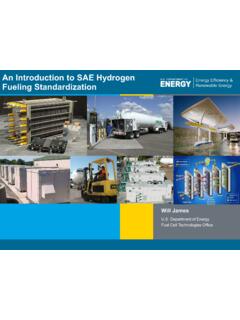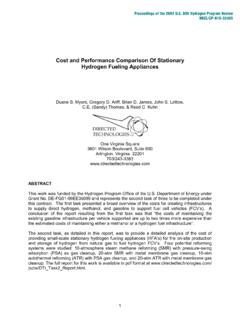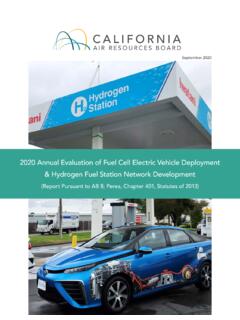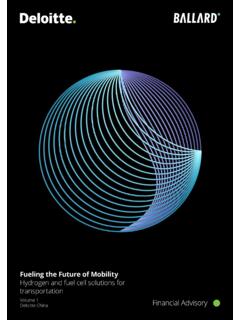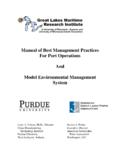Transcription of Autonomic Nervous System Drugs - Jones & Bartlett Learning
1 Autonomic Ner vous System Drugs William Mark Enlow Sue Greenfield Cliff Roberson KEY TERMS Acetylcholine Acetylcholinesterase Adrenal medulla Adrenergic agonists Adrenergic antagonists Adrenergic nerves Adrenergic receptors Autonomic Nervous System (ANS) Cardioselective Catecholamine Cholinergic agonists Cholinergic antagonists Cholinergic nerves Competitive inhibition Craniosacral System Direct-acting Dopamine Dual innervation Effector organs Endogenous Enteric Nervous System Epinephrine Ganglia Indirect-acting Muscarinic acetylcholine receptors Nicotinic acetylcholine receptors Noncompetitive inhibition Norepinephrine Parasympathetic Nervous System Pheochromocytoma Postganglionic neuron Preganglionic neuron Selectivity Sympathetic Nervous System Sympathomimetic Synapse Thoracolumbar System Vasopressor CHAPTER 5 adistockShutterStock, 13108/09/14 11:32 am Jones & Bartlett Learning , LLC.
2 NOT FOR SALE OR Autonomic Nervous System (ANS) controls a variety of involuntary regulatory responses that affect heart and respiration rates. It is responsible both for the fight or f light responses that represent the body s physiological response to crisis or stress and for the less crisis-driven functions of resting, repairing, digesting, and reproductive activities. Many of the Drugs used to treat common conditions of the heart, circulation, and especially blood pressure do so by intentionally altering the functioning of the OBJECTIVESAt the end of the chapter, the student will be able to:1. Understand which functions the Autonomic Nervous System (ANS) Understand the mechanism of action for ANS Compare and contrast the various classes of ANS Understand common indications and contraindications of ANS Detect adverse effects of ANS THREE SYSTEMS OF THE ANSAn early view of the ANS described it as being sepa-rate from the central Nervous System (CNS), which integrates sensory information in the brain and spinal cord.
3 It is more accurate to say that the ANS carries out tasks that originate in the CNS (Blessing & Gibbins, 2008), but in some instances it acts more or less autonomously in doing so. It is important to recognize, though, that the ANS and the CNS are not separate systems; they simply have different key functional responsibilities. Whereas the CNS super-vises all motor and cognitive functions, voluntary or otherwise, the ANS is primarily tasked with the involuntary functions of the body such as heartbeat, respiration, digestion, and so are three key components to the ANS (FIGURE 5 1), two of which are of primary concern in this discussion: the sympathetic Nervous System (SNS) and the parasympathetic Nervous System (PNS). The third component, the enteric Nervous System (ENS), is intrinsic to the digestive System yet it is still very important. The ENS carries out key functions in support of systemic neurologic and immunologic well-being, and is highly responsive to both physical and emotional stimuli.
4 For purposes of this discussion, however, the focus will mainly be on the SNS and CHAPTER 5 Autonomic Nervous System 13208/09/14 11:32 am Jones & Bartlett Learning , LLC. NOT FOR SALE OR parasympathetic impulses may result in unopposed sympathetic stimulation and increased heart rate. Conversely, increased sympathetic stimu-lation of the heart produces increases in heart rate and decreased sympathetic stimulation produces decreases in heart of ANS SystemsThe ANS can be thought of as being equivalent to a car racing team. One part is tasked with driving the car, keeping the vehicle going lap after lap and deal-ing with the stresses and quick responses needed as circumstances change. The other part (the pit crew) is tasked with keeping fuel and repairs in place so that both the driver and the car can continue doing their jobs. In this metaphor, the SNS is the driver; it increases metabolism and stimulates the cardio-vascular and pulmonary systems as the situation requires, whether that means maintaining a steady metabolic speed for normal activities or revving the engine in crisis situations.
5 Meanwhile, the PNS functions are similar to the activities of the pit crew; the PNS produces more targeted responses that facili-tate digestion, repair, and resting functions, enabling the body to maintain energy stores and recover from incidental damage. Finally, the ENS is more like the car itself; it responds to input from both the SNS and the PNS; while its functions are fairly specific and somewhat limited in scope, it is nevertheless central to the operation of the whole important component of this metaphor is that the functions of the pit crew (PNS) and the driver (SNS) are rarely engaged at the same time. One operates under certain circumstances, while the other operates under different circumstances yet together they can handle nearly all situations, whether it be routine maintenance, fueling , and upkeep or the critical stress of race time. The ENS, by comparison, is on the receiving end of signals from the PNS and SNS at any given moment; at the same time, it is always engaged and running, even when at rest (just as the brain is).
6 Anyone who has seen cars race understands that the crew, the car, and the driver all need to work well and work together for the race to go well. Similarly, the ANS is a highly integrated System in ANATOMY OF THE Autonomic Nervous SYSTEMThe ANS is, in essence, an extension of the CNS that manages the involuntary functions of the body; thus all signals that pass through ANS pathways origi-nate in either the spinal cord (both SNS and PNS) or the medulla of the brain (PNS). These impulses pass through a preganglionic neuron to bundles of synapses called ganglia, most of which then synapse to postganglionic neurons that pro-cess the signal to the appropriate effector organs, muscles, and other structures that they innervate. In both the SNS and the PNS, acetylcholine is the key neurotransmitter facilitating the preganglionic synapse. In the SNS, norepinephrine a stress hor-mone acts on the postganglionic neuron, while the PNS postganglionic neuron is excited once again by SNS and PNS often innervate the same organs (dual innervation), although their effects on that organ may be different.
7 For example, the heart is innervated by both sympathetic and para-sympathetic nerves. Increased parasympathetic stimulation of the heart will result in parasympa-thetic predominance and decreased heart rate, while FIGURE 5 1 Comparison of the two divisions of the Autonomic Nervous (2004). Paramedic: Anatomy & Physiology. Sudbury, MA: Jones and BartlettIntroduction 133 NerveimpulsePresynapticvesiclesPRESYNAPT ICMEMBRANEPOSTSYNAPTICMEMBRANEN eurotransmittermoleculeSYNAPTIC CLEFTAxonDendrite orcell 13308/09/14 11:32 am Jones & Bartlett Learning , LLC. NOT FOR SALE OR sometimes also referred to as the thoracolumbar nerves in the ANS release specific neu-rotransmitters that target a number of different receptors, listed in TABLE 5 1. Preganglionic sym-pathetic nerves release acetylcholine into synapses. Acetylcholine stimulates postganglionic nicotinic acetylcholine receptors, and impulses are propa-gated along postganglionic sympathetic nerves, which release adrenergic neurotransmitters pri-marily norepinephrine to produce systemic effects.
8 Because these preganglionic sympathetic nerves release acetylcholine, they are classified as cholin-ergic nerves. Postganglionic sympathetic nerves release adrenergic neurotransmitters and, there-fore, are classified as adrenergic nerves. Receptors responsive to adrenergic neurotransmitters adren-ergic receptors include alpha ( ), beta ( ), and dopamine (D) Nervous SystemThe PNS, similar to the SNS, is composed of pre-ganglionic and postganglionic nerves. However, pre-ganglionic parasympathetic nerve fibers originate in cranial nerves II, VII, XI, and X and sacral spinal nerves (S2 through S4). For this reason, the PNS is sometimes referred to as the craniosacral System (see Figure 5-1).which the major parts are mutually interdependent. Consequently, medications that alter how the ANS functions may be intended to act on one System , yet affect the others in unexpected ways. Understanding how the SNS and PNS interact will help the clini-cian to identify both how medical interventions may affect the ANS overall, and how those treatments may have more specific effects on the functions of certain components of the Nervous SystemSNS impulses are responses to a fairly specific set of stimuli requiring activation of the fight or f light response.
9 When someone crosses a street and sees a car moving quickly toward him or her, or suddenly coming around a corner and heading straight for the person the rush of energy he or she experiences while jumping out of the way is exactly this type of impulse. It is, as may have been experienced by the reader, highly suited toward propelling the body into motion, as it originates from the spine rather than the brain: the ganglia and nerves of the SNS connect the spinal cord to a specific set of organs. The sym-pathetic ganglia extend from the upper neck down to the coccyx and are found in paired chains close to and along each side of the thoracic and lumbar spine. Nerves carrying sympathetic fibers exit the spinal cord from T1 to L2. For this reason, the SNS 134 CHAPTER 5 Autonomic Nervous System DrugsTABLE 5 1 Types of Autonomic ReceptorsNeurotransmitterReceptorPrimary LocationsResponsesAcetylcholine (cholinergic)Nicotinic MuscarinicPostganglionic neurons Parasympathetic target: organs other than the heartHeartStimulation of smooth muscle and gland secretionsStimulation of smooth muscle and gland secretionsDecreased heart rate and force of contractionNorepinephrine (adrenergic)Alpha1 Alpha2 Beta1 Beta2 All sympathetic target organs except the heartPresynaptic adrenergic nerve terminalsHeart and kidneysAll sympathetic target organs except the heartConstriction of blood vessels, dilation of pupilsInhibition of release of norepinephrineIncreased heart rate and force of contraction; release of reninStory, L.
10 (2014). Pathophysiology: A practical approach, Second Edition. Burlington, MA: Jones & Bartlett 13408/09/14 11:32 am Jones & Bartlett Learning , LLC. NOT FOR SALE OR , epinephrine (also called adrena-line), by phenylethanolamine N-methyl transferase. Another endogenous catecholamine derivative is norepinephrine and epinephrine are metabolized by catechol-o-methyl transferase (COMT) and monoamine oxidase (MAO). Vanillyl-mandelic acid is the common metabolite for norepi-nephrine and epinephrine from both the COMT and MAO pathways (FIGURE 5 3).The PNS is the rest and repair part of the ANS. Its essential job is to transition the body to those functions that support the body s ability to renew itself. Thus it stimulates digestive secretions and gas-trointestinal (GI) tract activity to promote process-ing of nutrients, and it slows the heart and constricts the pupils to promote resting. The principal route of PNS signaling is along the vagus nerve; in conse-quence, impulses tend to move more slowly through the PNS.











